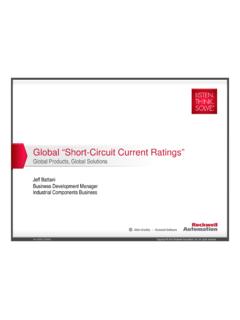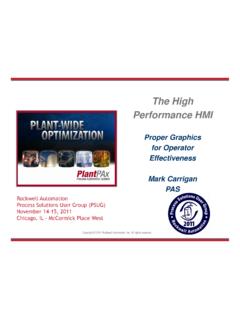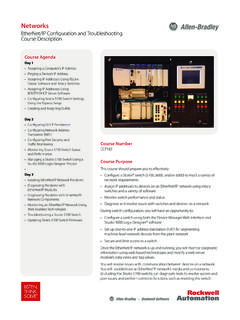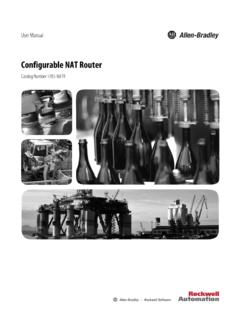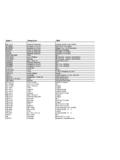Transcription of HOW TO CALCULATE ENCLOSURE HEAT LOAD …
1 HOW TO CALCULATE ENCLOSURE heat load AND WHY YOU NEED TO COOL ELECTRONICS. HOFFMAN MCLEAN SCHROFF PENTAIR HOFFMAN MCLEAN SCHROFF HOFFMAN MCLEAN SCHROFF 2 HARMFUL heat 2 Like people, industrial electronics can over- heat , causing malfunction and even complete failure. The good news is that electronic components can be kept cool to extend their life and prevent expensive operations downtime. PENTAIR HOFFMAN MCLEAN SCHROFF PENTAIR HOFFMAN MCLEAN SCHROFF HOFFMAN MCLEAN SCHROFF 3 LEARNING OBJECTIVES Understanding why temperature variation can be a problem Understand the consequences of over-heated electronics Learn the benefits of cooling industrial electronics Identify the sources of damaging heat Learn how to size a cooling unit for your cabinet HOFFMAN MCLEAN SCHROFF PENTAIR HOFFMAN MCLEAN SCHROFF HOFFMAN MCLEAN SCHROFF 4 HOFFMAN MCLEAN SCHROFF PENTAIR HOFFMAN MCLEAN SCHROFF HOFFMAN MCLEAN SCHROFF Typical devices housed
2 In an ENCLOSURE in an Automation Control System VARIABLE FREQUENCY DRIVE (VFD) SERVO DRIVE PROGRAMMABLE LOGIC CONTROLLER (PLC) STARTER KIT POWER SUPPLY INVERTER RELAYS TERMINAL BLOCKS INDICATOR LIGHTS TRANSFORMER* * Typically outside the control panel, but can sometimes be included inside the ENCLOSURE Electrical ENCLOSURE VFD WHY CAN TEMPERATURE VARIATION BE A PROBLEM? HOFFMAN MCLEAN SCHROFF PENTAIR HOFFMAN MCLEAN SCHROFF HOFFMAN MCLEAN SCHROFF WHY CAN TEMPERATURE VARIATION BE A PROBLEM? TEMPERATURE EXTREMES WILL CAUSE PROBLEMS AT HIGH TEMPERATURES: Drive performance is de-rated I/C- based devices behave strangely- funky output- voltage migration (Properties of silicone materials change with temp extremes) AT LOW TEMPERATURES Cooling below the dew point leads to condensation - promotes corrosion Batteries die I/C -based devices behave strangely 6 HOFFMAN MCLEAN SCHROFF PENTAIR HOFFMAN MCLEAN SCHROFF HOFFMAN MCLEAN SCHROFF 7 WHY CAN TEMPERATURE VARIATION BE A PROBLEM?
3 All Metal-Oxide-Semiconductor electronic components are sensitive to temperature changes: Metal Oxide field effect transistors (MOSFET) are no different Electrical characteristics Threshold voltage = Applied voltage to the gate The higher the temperature , the higher the threshold voltage trigger point requirements May cause the transistor to drift out of design requirements The higher the temperature, the longer it takes for the gate to open The higher the temperature the greater the internal resistance the gate may not open at all Result: the gate does not open when it is designed to, which adversely affects other components on the circuit Life Expectancy Properties of silicon oxide used in the components changes with temperature fluxuations HOFFMAN MCLEAN SCHROFF PENTAIR HOFFMAN MCLEAN SCHROFF HOFFMAN MCLEAN SCHROFF 8 WHY CAN TEMPERATURE VARIATION BE A PROBLEM?
4 In Wiring Insulation Elasticity and strength are reduced Ductility increases temporarily Atomic Mobility increases Mechanical properties of materials change with increasing temperatures HOFFMAN MCLEAN SCHROFF PENTAIR HOFFMAN MCLEAN SCHROFF HOFFMAN MCLEAN SCHROFF TREND TOWARD MORE heat As information processing becomes more powerful, the heat generated from electronics continues to increase. Semiconductor transistor density and performance double every 18-24 months. Moore s Law Named for Intel founder, Dr Gordon Moore The need for more electronics cooling continues to grow HOFFMAN MCLEAN SCHROFF PENTAIR HOFFMAN MCLEAN SCHROFF HOFFMAN MCLEAN SCHROFF HOFFMAN MCLEAN SCHROFF PENTAIR HOFFMAN MCLEAN SCHROFF HOFFMAN MCLEAN SCHROFF Every 10 C / 18 F over room temperature cuts electronics life in half.
5 Using cooling can avoid early automation drive replacement 010203040506070809010052 C / 126 F 42 C / 108 F 32 C / 90 F 22 C / 72 F 25% 50% 100% Source: DEC Study Percent of Electronics Life Expectancy WHY CAN TEMPERATURE VARIATION BE A PROBLEM? HOFFMAN MCLEAN SCHROFF PENTAIR HOFFMAN MCLEAN SCHROFF HOFFMAN MCLEAN SCHROFF 12 12 PENTAIR RUNNING HOT COMPONENTS IS A GAMBLE Depending on the equipment, allowing electronic components to run hot can be a costly gamble. Early replacement of industrial drives, hours of automation system downtime, and out-of-warranty conditions all become risks when cooling is not used.
6 HOFFMAN MCLEAN SCHROFF PENTAIR HOFFMAN MCLEAN SCHROFF HOFFMAN MCLEAN SCHROFF CONSEQUENCES OF HOT ELECTRONICS One hour of industrial operation downtime can cost big money A little investment in cooling can save huge costs later UP TO $500,000 PER HOUR! Lost production+ direct repair cost + lost opportunity cost= Cost of downtime HOFFMAN MCLEAN SCHROFF PENTAIR HOFFMAN MCLEAN SCHROFF HOFFMAN MCLEAN SCHROFF CONSEQUENCES OF HOT ELECTRONICS Operating electronics over its specified temperature could void the manufacturer s warranty. Using cooling can prevent unpleasant and expensive surprises HOFFMAN MCLEAN SCHROFF PENTAIR HOFFMAN MCLEAN SCHROFF HOFFMAN MCLEAN SCHROFF 15 HOFFMAN MCLEAN SCHROFF PENTAIR HOFFMAN MCLEAN SCHROFF HOFFMAN MCLEAN SCHROFF SOURCES OF DAMAGING heat VARIABLE FREQUENCY DRIVE (VFD) APPROX.
7 95 TO 98% EFFICIENT SERVO DRIVE >85% EFFICIENT POWER SUPPLY APPROX. 60 TO 83% EFFICIENT TRANSFORMER* APPROX. 95-99% EFFICIENT * Typically outside the control panel, but can sometimes be included inside the ENCLOSURE Typical efficiency of devices housed in an ENCLOSURE in an Automation Control System HOFFMAN MCLEAN SCHROFF PENTAIR HOFFMAN MCLEAN SCHROFF HOFFMAN MCLEAN SCHROFF 17 Most of these conditions require industrial control cooling SOURCES OF DAMAGING heat heat can also come from outside the electrical ENCLOSURE and radiate inside, further adding to the heat stress of the component.
8 SOLAR heat GAIN HOT WEATHER Dark-painted enclosures collect more heat than light-colored cabinets IRON FOUNDRY MINING heat radiates into the control cabinet from outside WELDING PROCESS INTENSE LIGHTING Applies extra heat load to the automation electronics inside DRYING OVEN BLAST FURNACE Many factories around the world are hot environments and use automation equipment HOFFMAN MCLEAN SCHROFF PENTAIR HOFFMAN MCLEAN SCHROFF HOFFMAN MCLEAN SCHROFF TERMS AND ABBREVIATIONS heat load The heat generated by the equipment or system and is usually given in Watts Max System Temperature TMAX The maximum internal system equipment temp allowable.
9 Ambient Temperature TA The Outside or Inlet Temperature to the equipment or system. Temperature Rise or T The difference between the Maximum Internal System Temp. and the Ambient Temperature. T = TMAX - TA TMAX TA AMBIENT heat load HOFFMAN MCLEAN SCHROFF PENTAIR HOFFMAN MCLEAN SCHROFF HOFFMAN MCLEAN SCHROFF TERMS AND ABBREVIATIONS Solar load This is the contribution to the heat load of the Sun on outdoor systems Noise Quoted in dB(A) The higher the number the louder the fan. Volumetric Flow Rate Air flow performance of the fan in free air ( fan blows in free space without static pressure) measured in CFM or m3/hr Static Pressure This is the amount of ambient air pressure.
10 As air pressure increases fan performance declines. In general, high static pressure in in an application is caused by air flow obstructions and/or inadequate venting HOFFMAN MCLEAN SCHROFF PENTAIR HOFFMAN MCLEAN SCHROFF HOFFMAN MCLEAN SCHROFF TERMS AND ABBREVIATIONS Fan Curve This is the key performance characteristic for a particular fan System Flow Resistance This curve represents the system or requirements resistance to the flow of air itself. Fan Performance vs System Flow (SCFM)Static Pressure (Inches H2O)Air Flow - CFM Static PressureInches (H2O) HOFFMAN MCLEAN SCHROFF PENTAIR HOFFMAN MCLEAN SCHROFF HOFFMAN MCLEAN SCHROFF CONVERSIONS/ASSUMPTIONS 1 Watt = BTU/HR 1 HP = 746 Watts 1 HP = 2546 BTU/HR If the efficiency of the drive is known, Watts lost to heat can be estimated if it is not supplied by the manufacturer.





